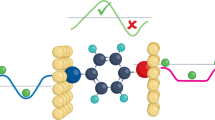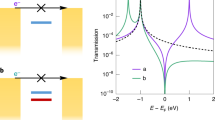Abstract
Molecular electronics aims to miniaturize electronic devices by using subnanometre-scale active components1,2,3. A single-molecule diode, a circuit element that directs current flow4, was first proposed more than 40 years ago5 and consisted of an asymmetric molecule comprising a donor–bridge–acceptor architecture to mimic a semiconductor p–n junction. Several single-molecule diodes have since been realized in junctions featuring asymmetric molecular backbones6,7,8, molecule–electrode linkers9 or electrode materials10. Despite these advances, molecular diodes have had limited potential for applications due to their low conductance, low rectification ratios, extreme sensitivity to the junction structure and high operating voltages7,8,9,11,12. Here, we demonstrate a powerful approach to induce current rectification in symmetric single-molecule junctions using two electrodes of the same metal, but breaking symmetry by exposing considerably different electrode areas to an ionic solution. This allows us to control the junction's electrostatic environment in an asymmetric fashion by simply changing the bias polarity. With this method, we reliably and reproducibly achieve rectification ratios in excess of 200 at voltages as low as 370 mV using a symmetric oligomer of thiophene-1,1-dioxide13,14. By taking advantage of the changes in the junction environment induced by the presence of an ionic solution, this method provides a general route for tuning nonlinear nanoscale device phenomena, which could potentially be applied in systems beyond single-molecule junctions.
This is a preview of subscription content, access via your institution
Access options
Subscribe to this journal
Receive 12 print issues and online access
$259.00 per year
only $21.58 per issue
Buy this article
- Purchase on Springer Link
- Instant access to full article PDF
Prices may be subject to local taxes which are calculated during checkout





Similar content being viewed by others
References
Nitzan, A. & Ratner, M. A. Electron transport in molecular wire junctions. Science 300, 1384–1389 (2003).
Tao, N. J. Electron transport in molecular junctions. Nature Nanotech. 1, 173–181 (2006).
Aradhya, S. V. & Venkataraman, L. Single-molecule junctions beyond electronic transport. Nature Nanotech. 8, 399–410 (2013).
Ellenbogen, J. C. & Love, J. C. Architectures for molecular electronic computers. I. Logic structures and an adder designed from molecular electronic diodes. Proc. IEEE 88, 386–426 (2000).
Aviram, A. & Ratner, M. A. Molecular rectifiers. Chem. Phys. Lett. 29, 277–283 (1974).
Mayor, M. et al. Electric current through a molecular rod—relevance of the position of the anchor groups. Angew. Chem. Int. Ed. 42, 5834–5838 (2003).
Diez-Perez, I. et al. Rectification and stability of a single molecular diode with controlled orientation. Nature Chem. 1, 635–641 (2009).
Lortscher, E. et al. Transport properties of a single-molecule diode. ACS Nano 6, 4931–4939 (2012).
Batra, A. et al. Tuning rectification in single-molecular diodes. Nano Lett. 13, 6233–6237 (2013).
Kim, T., Liu, Z. F., Lee, C., Neaton, J. B. & Venkataraman, L. Charge transport and rectification in molecular junctions formed with carbon-based electrodes. Proc. Natl Acad. Sci. USA 111, 10928–10932 (2014).
Elbing, M. et al. A single-molecule diode. Proc. Natl Acad. Sci. USA 102, 8815–8820 (2005).
Stokbro, K., Taylor, J. & Brandbyge, M. Do Aviram–Ratner diodes rectify? J. Am. Chem. Soc. 125, 3674–3675 (2003).
Dell, E. J., Capozzi, B., Xia, J., Venkataraman, L. & Campos, L. M. Molecular length dictates the nature of charge carriers in single-molecule junctions of oxidized oligothiophenes. Nature Chem. 7, 209–214 (2015).
Barbarella, G., Pudova, O., Arbizzani, C., Mastragostino, M. & Bongini, A. Oligothiophene-S,S-dioxides: a new class of thiophene-based materials. J. Org. Chem. 63, 1742–1745 (1998).
Xu, B. Q. & Tao, N. J. Measurement of single-molecule resistance by repeated formation of molecular junctions. Science 301, 1221–1223 (2003).
Nagahara, L. A., Thundat, T. & Lindsay, S. M. Preparation and characterization of STM tips for electrochemical studies. Rev. Sci. Instrum. 60, 3128–3130 (1989).
Metzger, R. M. Unimolecular electrical rectifiers. Chem. Rev. 103, 3803–3834 (2003).
Nerngchamnong, N. et al. The role of van der Waals forces in the performance of molecular diodes. Nature Nanotech. 8, 113–118 (2013).
Ciszkowska, M. & Stojek, Z. Voltammetry in solutions of low ionic strength. Electrochemical and analytical aspects. J. Electroanal. Chem. 466, 129–143 (1999).
Bard, A. J. & Faulkner, L. R. Electrochemical Methods: Theory and Applications (Wiley, 2001).
Paulsson, M. & Datta, S. Thermoelectric effect in molecular electronics. Phys. Rev. B 67, 241403 (2003).
Quek, S. Y. et al. Mechanically controlled binary conductance switching of a single-molecule junction. Nature Nanotech. 4, 230–234 (2009).
Quek, S. Y. et al. Amine–gold linked single-molecule circuits: experiment and theory. Nano Lett. 7, 3477–3482 (2007).
Darancet, P., Widawsky, J. R., Choi, H. J., Venkataraman, L. & Neaton, J. B. Quantitative current–voltage characteristics in molecular junctions from first principles. Nano Lett. 12, 6250–6254 (2012).
Adak, O., Korytar, R., Joe, A. Y., Evers, F. & Venkataraman, L. Impact of electrode density of states on transport through pyridine-linked single molecule junctions. Preprint at http://arXiv.org/abs/1504.00242 (2015).
Brandbyge, M., Mozos, J. L., Ordejon, P., Taylor, J. & Stokbro, K. Density-functional method for nonequilibrium electron transport. Phys. Rev. B 65, 165401 (2002).
Fatemi, V., Kamenetska, M., Neaton, J. B. & Venkataraman, L. Environmental control of single-molecule junction transport. Nano Lett. 11, 1988–1992 (2011).
Guo, X. F. et al. Covalently bridging gaps in single-walled carbon nanotubes with conducting molecules. Science 311, 356–359 (2006).
Prins, F. et al. Room-temperature gating of molecular junctions using few-layer graphene nanogap electrodes. Nano Lett. 11, 4607–4611 (2011).
Venkataraman, L., Klare, J. E., Nuckolls, C., Hybertsen, M. S. & Steigerwald, M. L. Dependence of single-molecule junction conductance on molecular conformation. Nature 442, 904–907 (2006).
Widawsky, J. R. et al. Measurement of voltage-dependent electronic transport across amine-linked single-molecular-wire junctions. Nanotechnology 20, 434009 (2009).
Huber, R. et al. Electrical conductance of conjugated oligormers at the single molecule level. J. Am. Chem. Soc. 130, 1080–1084 (2008).
Neaton, J. B., Hybertsen, M. S. & Louie, S. G. Renormalization of molecular electronic levels at metal–molecule interfaces. Phys. Rev. Lett. 97, 216405 (2006).
Perdew, J. P., Burke, K. & Ernzerhof, M. Generalized gradient approximation made simple. Phys. Rev. Lett. 77, 3865–3868 (1996).
Acknowledgements
The authors thank M. Hybertsen and M. Steigerwald for discussions. The experimental work was supported primarily by the National Science Foundation (award no. DMR-1206202). E.J.D. acknowledges the HHMI, the American Australian Association and Dow Chemical Company for International Research Fellowships. The computational work was supported by the Molecular Foundry, and by the Materials Sciences and Engineering Division (Theory FWP), US Department of Energy, Office of Basic Energy Sciences (contract no. DE-AC02-05CH11231). Portions of the computation work were performed at National Energy Research Scientific Computing Center. O.A. acknowledges support from the NSF (award no. DMR-1122594). L.V. thanks the Packard Foundation for support.
Author information
Authors and Affiliations
Contributions
Experiments were conceived and designed by B.C., O.A., L.M.C., J.B.N. and L.V. and performed by B.C., O.A. and J.C.T. Data analysis was carried out by B.C. and O.A. Compounds were synthesized by J.L. and E.J.D. Calculations were performed by Z-F.L. and J.B.N. The manuscript was co-written by B.C., J.B.N., L.M.C. and L.V., with input from all authors.
Corresponding authors
Ethics declarations
Competing interests
The authors declare no competing financial interests.
Supplementary information
Supplementary information
Supplementary Information (PDF 4967 kb)
Rights and permissions
About this article
Cite this article
Capozzi, B., Xia, J., Adak, O. et al. Single-molecule diodes with high rectification ratios through environmental control. Nature Nanotech 10, 522–527 (2015). https://doi.org/10.1038/nnano.2015.97
Received:
Accepted:
Published:
Issue Date:
DOI: https://doi.org/10.1038/nnano.2015.97
This article is cited by
-
Nanoscale molecular rectifiers
Nature Reviews Chemistry (2023)
-
In-situ electro-responsive through-space coupling enabling foldamers as volatile memory elements
Nature Communications (2023)
-
Voltage-driven control of single-molecule keto-enol equilibrium in a two-terminal junction system
Nature Communications (2023)
-
Advances in single-molecule junctions as tools for chemical and biochemical analysis
Nature Chemistry (2023)
-
Room-temperature logic-in-memory operations in single-metallofullerene devices
Nature Materials (2022)



